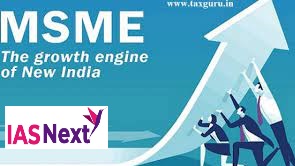CURRENT AFFAIRS
Get the most updated and recent current affair content on Padhaikaro.com
MSMEs Engines of Growth for New India
- IAS NEXT, Lucknow
- 05, Jan 2022

Why in news?
Recently the government has revised the definition of MSME making it as engines of growth for ‘new India’.
Why MSME is important for Indian Economy?
- Contributes ~ 30% to India’s GDP
- Employs ~ 11 crore people
- Constitutes ~ 40% of total exports
- More than half of them located in rural India
- Huge potential to boost self-reliance (Atmanirbhar Bharat)
What are the issues faced by MSMEs in India?
- Regulatory limits on their assets discourage MSMEs from scaling up their operations.
- Only after a gap of 14 years (2006 to 2020) the government revised the definition of MSMEs by factoring in inflation and depreciation.
- This made the MSMEs to operate at a low scale by creating subsidiaries/sister concerns with a view to receiving incentives from the government.
- Inadequate and untimely credit – 9/10 MSMEs depend on informal sources for their working capital and term loans.
- Lack of sufficient asset cover (collateral) discourages them from taking secured loans at lower interest rate.
- This dents profitability and economic viability of their businesses.
- Other issues –
- Non-registration of firms.
- Delayed receivables.
- Technological obsolescence.
- Negligible market linkages.
- Information asymmetry.
- Absence of exit policy.
How will the new reforms benefit MSMEs?
- Special Credit Linked Capital Subsidy Scheme provides 25% capital subsidy for the MSMEs in the services sector for procuring service equipment through institutional credit for advancement of their technology.
- Revising the definition of MSMEs – According to the new definition a firm is classified under MSME-Medium category if
- Investment in plant and machinery does not exceed Rs50 crore
- Turnover does not exceed Rs250 crore.
- This change in the policy gave a ‘comfort zone’ for the MSMEs.
- Export revenue is deducted from total sales while estimating the turnover of MSMEs
- This is a positive sign not only for MSME sector but also for exports.
What are the areas to improve in this sector?
Ease Of Doing Business –
- Better access to efficient factors of production.
- Friendly labour reforms
- Proper land acquisition policy
- Free access to capital
- Vibrant entrepreneurship culture
- Modern technology
- Enabling infrastructure.
- Simplified tax policy.
Export of Services –
- The world is moving towards a clean, green, and lean corporate regime and India has a comparative advantage in services sector
- MSMEs must be re-oriented to enhance export of services by capitalising the revised definition.
- However, balanced growth of agriculture, manufacturing, and services may be maintained by leveraging demographic dividend.
Leveraging PLI Scheme – PLI Scheme will
- Boost 13 industry sectors
- Harness Make in India and enhance our manufacturing and export potential.
- Incentivise the manufacturing of electric vehicles
Promoting Start-Ups –
- According to Nasscom India has 66 unicorns till date and is still counting.
- They should be nurtured with right incentives like market capitalisation and evolving technology.
Market Linkages –
- A virtual platform exhibiting the products and innovations of MSMEs must be created to reach out to the broader national and international markets thereby enhancing their revenue.
- Brand their products/services to promote (RURBAN) clusters.
Emulating Best Practices-
- Turkey has introduced ‘TURQUALITY’ a state sponsored scale up programme to transform MSME into global players.
- ‘Growth Driver Programme’ of Business Development Bank of Canada provides multi-disciplinary support system in terms of enterprise growth and job creation in SMEs.
Financial Literacy and Education –
- Imparting financial/digital education
- Make use of digital channels including TReDS platform for speedy realisation of their receivables.
- Train to utilise the services of SME stock exchange in order to mobilise risk capital for growth plans.